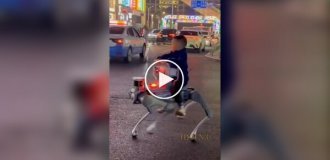Rare and interesting photo materials from the fronts of World War II (21 photos)
The Second World War lasted 6 years and 1 day (2195 days). It began on September 1, 1939 and ended on September 2, 1945, when Japan surrendered. 57 countries took part in it. 
A woman repairs a tank. England, 1940.
The photo shows a British Matilda MK1 tank. This model was the first serial one from the British. It was produced since 1937. Only 139 were produced, most of them lost in 1939-40 on the European continent. A small number of tanks remained in the British Isles in training units, where, apparently, this photo was taken. 
A British paratrooper removes a Welbike folding motorcycle from a container during training with the 3rd Parachute Brigade, 1943. A total of 3,853 of these folding motorcycles were produced. They were intended for special operations, such as "Market Garden". It could be dropped by parachute in a cylindrical container 15 inches (38 cm) in diameter. 
Carpet bombing during World War II by B-29-25-BA Superfortresses
A Boeing B-29 drops bombs over Rangoon, Burma. The closest aircraft is a B-29-25-BA from the 871st Bomb Squadron, 497th Bomb Group, 20th Air Force. This plane was reported to have been shot down by flak on March 24, 1945, near Nagoya, Japan. 
Farewell at Penn Station. New York City, January 1, 1944. 
Seals on Air Patrol. USA, 1940s.
The Cat Patrol Never Sleeps. 
A photograph of a British soldier posing in front of a recently captured German 380mm gun of the Todt Battery on the Cape Gris-Nez (France). 1944.
The guns (there are 4 of them in the battery) were located to block the English Channel with the ability to fire on the coast of Great Britain. The gunners in the battery were not soldiers from the ground forces (Wehrmacht), but sailors (Kriegsmarine).
Currently, one of the checkpoints of the Todt Battery houses the Atlantic Wall Museum. 
French Resistance fighters build a barricade in Paris, August 1944. 
A soldier and his mother in a strawberry field. Florin, Sacramento County, California, 1942. A little about this family: The 23-year-old soldier volunteered for the war on July 10, 1941. He was sent on leave to help his mother and family prepare for evacuation. In 1942, all Japanese-Americans were forcibly removed from the Pacific coast, including California and much of Oregon and Washington, to internment camps. He is the youngest of six children, two of whom are volunteers in the United States Army. His mother, 53, came from Japan 37 years ago. Her husband died 21 years ago, leaving her to raise six children alone. She worked in a strawberry basket factory until her children leased three acres of strawberries last year so she could work for herself. 
Rommel inspects fortifications on the beach that will soon become the Utah landing zone. Normandy, 1944.
The fortifications were located near the French town of Sangat at Cape Bely Nos. These wooden structures were intended to hold back enemy transport in the event of a landing. 
Ethnic Germans in Poland greet German soldiers and treat them to something tasty. September 1939.
Who knows, maybe it's the women from the Polish partisan detachment who give the Germans poisoned food. Anything can happen during military conflicts. 
The damaged aircraft carrier "Franklin", 1945.
This photo was taken from the Santa Fe alongside the listing USS Franklin, which was damaged during the Battle of Okinawa. The damage was caused by a single attack by a single Japanese aircraft, which dropped only two bombs. The first penetrated the flight deck forward of the main superstructure, causing the fuel and ammunition of the aircraft being prepared for takeoff to detonate. The second damaged the aft section, penetrating the two upper decks and exploding inside. In terms of the number of sailors lost, Franklin (CV-13) is second only to the battleship Arizona (BB-39) at Pearl Harbor. 
U.S. Army troops come ashore at Omaha Beach during the D-Day invasion on June 6, 1944. You may have seen this scene in many WWII movies or computer games. The Normandy invasion involved 160,000 soldiers, 195,700 sailors. 
Libensky Bridge, Prague, July 1942.
The Germans collected bells from all over the country to melt down to use the metal for military purposes. During the entire occupation, 43,776 bells were removed and melted down in the former Czechoslovakia. 
German Chancellor Adolf Hitler with German actress Olga Chekhova during a reception at the home of Foreign Minister Joachim von Ribbentrop in Dahlem, Berlin, May 22, 1939. There is a legend that the actress gained Hitler's trust. And before that, she was recruited in the Soviet Union. The actress kept a diary in which there is this line: "The rumors that are spread about me are worthy of a novel. Apparently, someone got the information that I was Hitler's mistress... Incredible and vile slander. Will they believe me - time will tell...". 
Captain Lewis Nixon suffers from a hangover after celebrating Victory Day in Hitler's "Eagle's Nest", 1945.
The "Eagle's Nest" contained a collection of 10,000 bottles of alcohol: wine, champagne. This entire collection was collected over the years by the political, state and military figure of Nazi Germany - Hermann Goering. 
A woman drinks tea in the ruins of her home after the bombing of London, 1940.
Since the beginning of the Great Blitz, London had been bombed for 57 consecutive nights. By the end of May 1941, more than 40,000 civilians, half of them in London, had been killed in the bombing. 
Winston Churchill meets Billy the Goat, the mascot of the Royal Welsh Fusiliers, 1943. 
Two Canadian airwomen in fancy dress enjoy a drink at a victory party in Sudbury, Surrey, September 19, 1945.
It is interesting that in those years even female pilots had a uniform with a skirt. Trousers later came into regular use. 
Photographer Reg Speller
A former German soldier who returned from captivity reads announcements on a tree about the search for relatives. Dresden, 1946.
The Allies bombed Dresden, despite the fact that there was not a single military unit of the Reich there, the famous Dresden Gallery was badly damaged by the bombing.
It was an act of intimidation, the same in essence as the atomic bombing of Hiroshima and Nagasaki later. 
Home-cooked dinner in post-war Warsaw, 1945.
The photo is clearly staged: no wallpaper, not even scraps of it on the walls, no traces of fire that could have destroyed this wallpaper, but there is a whole parquet floor. But it conveys the atmosphere of the city after the war well. 






















